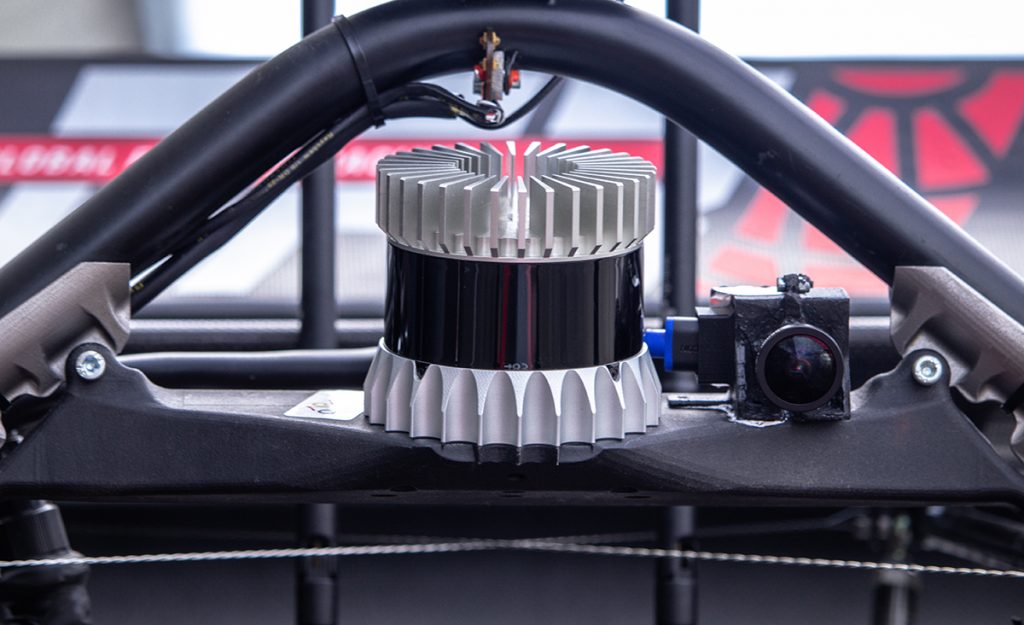
Global Formula Racing — the partnership between Oregon State University and German university DHBW Ravensburg— has a storied and stellar track record. Since 2010, the team has racked up multiple top-10 finishes in race cars designed and built from the ground up.
So when the team took second place at Formula Student Germany earlier this month, it was no surprise. But when the car rolled across the finish line in Hockenheim, it was more than the end of the race, it was the end of an era.

This was the last time the team would race a car reliant on fossil fuels. For much of the last decade, GFR has raced both a traditional gas powered formula car alongside a fully electric version. Beginning next year, they will only be building battery powered ones.
In addition to being electric, GFR’s future is also autonomous. While FS Germany marked the end of the combustion car, it was also the debut of the team’s new driverless car.

“Market forces are pushing automobile manufacturers towards driverless tech,” said Kyle O’Brien, a graduate student in robotics who is the team’s lead for integrating the driverless system. “We want to remain on the cutting edge by embracing new technologies as they are developed.”
Additionally, several Formula Student competitions are moving toward integrating driverless and driven races. In 2021, Formula Student Germany will require hybrid cars that have a driver for some events and are driven autonomously in others. “To remain competitive we have chosen to begin developing our autonomous systems now,” O’Brien said.
“I like that it introduces new challenges to Formula Student,” said Amy Nye (’19 B.S, mechanical engineering), the team lead for chassis and composites. “Often, Formula Student teams get stuck within the boundaries of their current design, and this shift to driverless has provided an opportunity to really explore more.”
Driverless also brings a greater need for an interdisciplinary approach beyond mechanical engineering. The team is meeting that need by bringing in students from computer science, electrical engineering, and robotics, as well as others from disciplines outside the College of Engineering like business.
“Watching the new team develop and finally getting to see the car drive at competition is exciting,” O’Brien said. “Racing is an iterative design, and for the driverless vehicle, we started at a blank slate. We had to figure out which algorithms we should and shouldn’t use, the best way to brake or steer by actuation, and how to integrate our controls with an already built high-voltage drivetrain.”
“Initially, I was hesitant about the shift to driverless,” said Nathan Rust (’18 B.S, mechanical engineering), the manufacturing technical lead for the team. “Typical racing is a contest of engineering and personal skill, while driverless racing does not include the latter.” He said his hesitance went away at FS Germany in 2018 when he was amazed by seeing a driverless Formula Student car in action.
“Now, I think that the transition is exciting,” he said. “But I would still like to see a strong support for both traditional driven combustion and electric powertrain Formula Student cars, because I think that they both draw a lot of passion and emotion that can get more people involved with Formula Student.”
Ultimately, technical issues kept the driverless car from competing in a number of dynamic events at FS Germany and later at FS Spain. However, the car did well enough in static events to earn eighth and sixth place respectively.
“The biggest challenge was figuring out what we didn’t know,” O’Brien said. “Racing is an iterative design, and for the driverless vehicle we started at a blank slate. Looking back we definitely made some things harder on ourselves, but they will be fixed in the next iteration for the 2020 season.”
Both Nye and Rust, who are staying at Oregon State to pursue graduate degrees in mechanical engineering, plan to help meet that challenge by mentoring new undergraduates on the team.
“I actually chose Oregon State because of GFR,” Nye said. “I wanted to move to a school that had really good extracurricular engineering clubs, and while doing research, I stumbled across GFR and Oregon State. After watching the team’s videos, I got hooked. Since then, this team is my life and I’ve become a much better engineer because of it.”
Bob Paasch, professor of mechanical engineering and team advisor, echoed this sentiment. “Formula Student is not just about race cars; it’s about developing engineers,” he said. “It’s about figuring out what the problem is, coming up with a good solution to that problem, and then executing that solution.”
GFR's 2019 Results Combustion car 2nd FS Germany 5th Formula SAE Michigan 12th FS Austria and Siemens Mentor Chairs Award Electric car 31st FS Germany Driverless car 6th FS Spain 8th FS Germany
